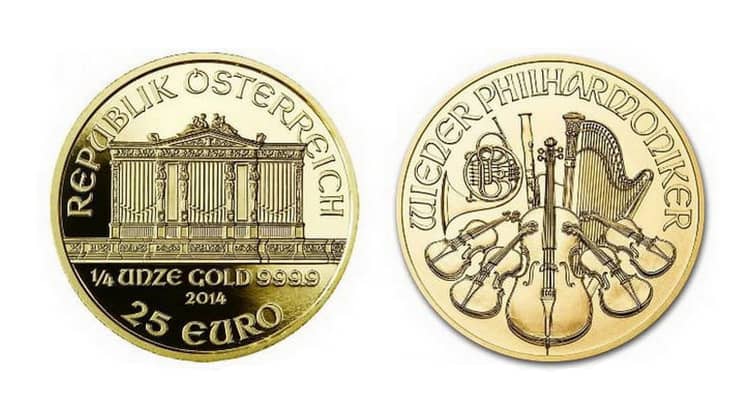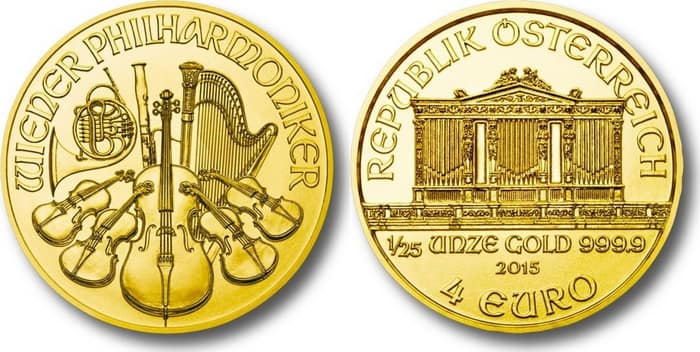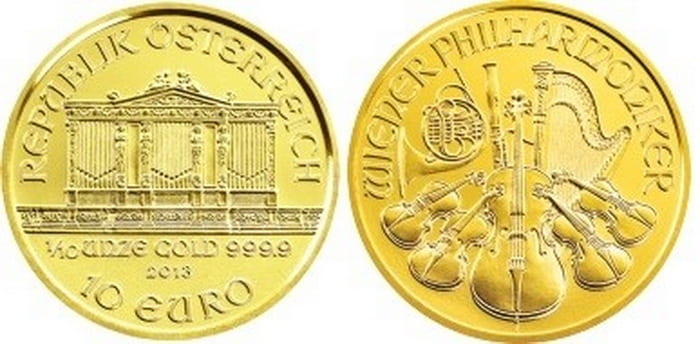
Еру «Philharmoniker» (gold series) – the first series of gold coins that was issued in euros. It had been issued in Austrian shillings since 1989. However, since 2002 it has been changed into euro. Now the coin of 1 ounce equals 100 euros, ½ ounce – 50 euros, ¼ ounce –25 euros and 1/10 ounce – 10 euros. To this day gold «Philharmonikers» are the best-selling investment coins in the world.
From the moment of its appeal in October 1989 and up to 2012 there were sold more than 14 million «Vienna Philharmonic», which equals 9.6 million ounces or 329 tons of gold.
Coins issued in shillings
Before 2002 all gold «Philharmonikers» had a face value in shillings. There were only four of them: 2000 shillings – 1 ounce, 1000 shillings – ½ ounce, 500 shillings – ¼ ounce and 200 shillings – 1/10 ounce.

Number of gold shillings issued in the period from 1989 to 2001
| Year of minting | 200 shillings | 500 shillings | 1000 shillings | 2000 shillings |
| 1989 | — | 272000 | — | 351000 |
| 1990 | — | 162000 | — | 484500 |
| 1991 | 82500 | 146000 | — | 233500 |
| 1992 | 99000 | 176000 | — | 537000 |
| 1993 | 99500 | 126000 | — | 234000 |
| 1994 | 112000 | 121200 | 94700 | 218600 |
| 1995 | 151100 | 156000 | 57400 | 645500 |
| 1996 | 128300 | 139200 | 88000 | 377600 |
| 1997 | 115300 | 100700 | 68200 | 408300 |
| 1998 | 102800 | 90800 | 47300 | 330300 |
| 1999 | 145000 | 81600 | 44200 | 230700 |
| 2000 | 32600 | 25900 | 20500 | 245700 |
| 2001 | 24400 | 25800 | 26800 | 54700 |
Coins issued in euros
4 euro Denomination
- Minting: 2014, 2015, 2018.
- Diameter: 13 mm.
- Thickness: 1.2 mm.
- Weight: 1.2441 g.
- Composition: Au 999.9 (gold).
- Edge: reeded.
- Obverse: Musical orchestra instruments are depicted on the obverse: four violins, a Vienna horn, a bassoon, a cello and a harp. Above the main engraving there’s an inscription: «WIENER PHILHAMONIKER», which means “Vienna Philharmonic” in German.
- Reverse: In the center of the coin there’s an engraving of a big pipe organ from the Golden Hall of the Vienna Philharmonic. Above it there’s an inscription «REPUBLIK ÖSTERREICH» which in translation from German means «Republic of Austria». Under the organ appears its weight in ounces, fineness, the year of issue and its face value.
4 Euro Gold Philharmoniker coins in GoldAdvert catalog.

10 euro Denomination
- Minting:
- 2002 – 75789 coins;
- 2003 – 59654 coins;
- 2004 – 67994 coins;
- 2005 – 62071 coins;
- 2006 – 39892 coins;
- 2007 – 76325 coins;
- 2008 – 76700 coins;
- 2009 – 437700 coins;
- 2010 – 226700 coins.
- Diameter: 16 mm.
- Thickness: 1.2 mm.
- Weight: 3.121 g.
- Composition: Au 999.9 (gold).
- Edge: reeded.
- Obverse: Musical orchestra instruments are depicted on the obverse: four violins, a Vienna horn, a bassoon, a cello and a harp. Above the main engraving there’s an inscription: «WIENER PHILHAMONIKER», which means “Vienna Philharmonic” in German.
- Reverse: In the center of the coin there’s an engraving of a big pipe organ from the Golden Hall of the Vienna Philharmonic. Above it there’s an inscription «REPUBLIK ÖSTERREICH» which in translation from German means «Republic of Austria». Under the organ appears its weight in ounces, fineness, the year of issue and its face value.
10 Euro Gold Philharmoniker coins in GoldAdvert catalog.

25 euro Denomination
- Minting:
- 2002 – 40807 coins;
- 2003 – 34019 coins;
- 2004 – 32449 coins;
- 2005 – 32817 coins;
- 2006 – 29609 coins;
- 2007 – 34631 coins;
- 2008 – 97100 coins;
- 2009 – 172000 coins;
- 2010 – 84900 coins.
- Diameter: 22 mm.
- Thickness: 1.2 mm.
- Weight: 7.776 g.
- Composition:Au 999.9 (gold).
- Edge: reeded.
- Obverse: Musical orchestra instruments are depicted on the obverse: four violins, a Vienna horn, a bassoon, a cello and a harp. Above the main engraving there’s an inscription: «WIENER PHILHAMONIKER», which means “Vienna Philharmonic” in German.
- Reverse: In the center of the coin there’s an engraving of a big pipe organ from the Golden Hall of the Vienna Philharmonic. Above it there’s an inscription «REPUBLIK ÖSTERREICH» which in translation from German means «Republic of Austria». Under the organ appears its weight in ounces, fineness, the year of issue and its face value.
25 Euro Gold Philharmoniker coins in GoldAdvert catalog.

50 euro Denomination
- Minting:
- 2002 – 40922 coins;
- 2003 – 26848 coins;
- 2004 – 24269 coins;
- 2005 – 21049 coins;
- 2006 – 20085 coins;
- 2007 – 25091 coins;
- 2008 – 73800 coins;
- 2009 – 92300 coins;
- 2010 – 56600 coins.
- Diameter: 28 mm.
- Thickness: 1.6 mm.
- Weight: 15.552 g.
- Composition: Au 999.9 (gold).
- Edge: reeded.
- Obverse Musical orchestra instruments are depicted on the obverse: four violins, a Vienna horn, a bassoon, a cello and a harp. Above the main engraving there’s an inscription: «WIENER PHILHAMONIKER», which means “Vienna Philharmonic” in German.
- Reverse: In the center of the coin there’s an engraving of a big pipe organ from the Golden Hall of the Vienna Philharmonic. Above it there’s an inscription «REPUBLIK ÖSTERREICH» which in translation from German means «Republic of Austria». Under the organ appears its weight in ounces, fineness, the year of issue and its face value.
50 Euro Gold Philharmoniker coins in GoldAdvert catalog.

100 euro Denomination
- Minting:
- 2002 – 164105 coins;
- 2003 – 179881 coins;
- 2004 – 176319 coins;
- 2005 – 158564 coins;
- 2006 – 82174 coins;
- 2007 – 108675 coins;
- 2008 – 715800 coins;
- 2009 – 903000 coins;
- 2010 – 512000 coins.
- Diameter: 37 mm.
- Thickness: 2.0 mm.
- Weight:31.103 g.
- Composition: Au 999.9 (gold).
- Edge: reeded.
- Obverse: Musical orchestra instruments are depicted on the obverse: four violins, a Vienna horn, a bassoon, a cello and a harp. Above the main engraving there’s an inscription: «WIENER PHILHAMONIKER», which means “Vienna Philharmonic” in German.
- Reverse: In the center of the coin there’s an engraving of a big pipe organ from the Golden Hall of the Vienna Philharmonic. Above it there’s an inscription «REPUBLIK ÖSTERREICH» which in translation from German means «Republic of Austria». Under the organ appears its weight in ounces, fineness, the year of issue and its face value.
100 Euro Gold Philharmoniker coins in GoldAdvert catalog.

2,000 euro Denomination
- Minting: 2009 – 6027 coins.
- Diameter: 74 mm.
- Thickness: 8.3 mm.
- Weight: 622 g.
- Composition: Au 999.9 (gold).
- Edge: reeded.
- Obverse: Musical orchestra instruments are depicted on the obverse: four violins, a Vienna horn, a bassoon, a cello and a harp. Above the main engraving there’s an inscription: «WIENER PHILHAMONIKER», which means “Vienna Philharmonic” in German.
- Reverse: In the center of the coin there’s an engraving of a big pipe organ from the Golden Hall of the Vienna Philharmonic. Above it there’s an inscription «REPUBLIK ÖSTERREICH» which in translation from German means «Republic of Austria». Under the organ appears its weight in ounces, fineness, the year of issue and its face value.
2000 Euro Gold Philharmoniker coins in GoldAdvert catalog.
The 20 ounce gold coin with a face value of 2,000 euros was issued for the 20th anniversary of the «Vienna Philharmonic». At the time of its emission in October of 2009, its material value was about 14,000 euros. Due to its limited minting, the coin was sold at about 10 % premium over the price of gold.
Total emission of these coins was 6,027 (with a condition that there will be 2,009 coins sold in each of the European, American and Japanese markets). They were sold in velvet-lined wooden cases with certificates.
100,000 euro Denomination
- Minting: 2004 – 15 coins.
- Diameter: 370 mm.
- Thickness: 20 mm.
- Weight: 31.103 kg.
- Composition: Au 999.9 (gold).
- Edge: reeded.
- Obverse: Musical orchestra instruments are depicted on the obverse: four violins, a Vienna horn, a bassoon, a cello and a harp. Above the main engraving there’s an inscription: «WIENER PHILHAMONIKER», which means “Vienna Philharmonic” in German.
- Reverse: In the center of the coin there’s an engraving of a big pipe organ from the Golden Hall of the Vienna Philharmonic. Above it there’s an inscription «REPUBLIK ÖSTERREICH» which in translation from German means «Republic of Austria». Under the organ appears its weight in ounces, fineness, the year of issue and its face value.
100000 Euro Gold Philharmoniker coins in GoldAdvert catalog.

Historical reference
«The Big Phil» is a gold “Philharmoniker” with a nominal value of 100,000 euros and the weight of a bit more than 31 kg. The dimensions of the coin were proportionally increased by tenfold over the 100 euros coin. The «Big Phil» was issued 10 times thicker,10 times wider and 1,000 times heavier than the 1 ounce coin (100 euros). It was one of the biggest coins in the world up until 2007, when it was eclipsed by «Royal Canadian Mint» (gold «Canadian Maple Leaf») 100 kilos and nominal value of 1,000,000 CA dollars.
The «Big Phil» was first symbolically introduced to the public in front of the «Wiener Riesenrad» – a huge Ferris wheel in Vienna. It is situated at the entrance to the «Prater» amusement park in Leopoldstadt. One of the coins is displayed in the foyer of the Munich office of «PRO AURUM», a company specializing in precious metals.
Why they created a gold series of «Philharmoniker»
These coins were issued as investment pieces, but more often they enhance private collections of numismatists. You can buy them one at a time or in sets of four, two or three different denominations.
For example, there was issued a series of two «Vienna Philharmonic» gold coins with denominations of 25 and 100 euros. The total weight of the coins was 38.88 g with the total circulation – 5,000 sets.

Design
It must be said that the design of the «Philharmonikers» hasn’t changed once since the beginning of its emission. It was created by the Austrian Mint’s («Munze Osterreich AG») chief engraver – Thomas Pesendorfer. He got this high position in 1993. Creation and design of «Philarmoniker» became his most famous and important work.

When the emission of this coin started
The Austrian Mint issued the very first edition of these coins on October 10, 1989 in honor of the world famous Vienna Philharmonic orchestra. «Vienna Philharmonic» or «Philharmoniker» was a couple of times declared the best-selling and the most popular gold coin in the world. This fact was proved by the record sales in 1992, 1995,1996 and 2000.
What types of the coin were in circulation
Before 2002 when «Phihlarmoniker» was issued in shillings, there were only four denominations: 200, 500, 1,000 и 2,000 shillings.
After that 10, 20, 50 and 100 euros became the main denominations in euros. In addition to that in 2004 there were issued 15 gold coins of 100,000 euros dedicated to the 15th anniversary of this series. As a dedication to 25th anniversary of this series they issued a coin with a nominal value of 4 euros in 2014. But the most rare and least known is the gold coin of 2009 with a nominal value of 2,000 euros.
What mint was issuing the coins
The premise for creation of the mint was an event that took place in 1194. At that time Richard the Lionheart was imprisoned and he had to pay for his liberation. He had to give as much as 12 tons of silver to the Archduke of Austria Leopold. Of course, this amount of precious metal was used for mintage of coins.
First the mint was next to Hoher Markt, and then it was moved to Wollzeile. From the beginning of the 19th century and up until our days it has been in the center of Austria – Vienna. Apart from that, there were mints in five different cities before 1918. But after the decay of Austro-Hungary there was only one central mint in Vienna left. In 1989 it was renamed the Austrian mint, which is a subsidiary enterprise of the National Bank of Austria.
Cost of the coins
The cost of «Vienna Philharmonic» gold coin on the market is fairly relational. It depends on the price swings at the London Metal Exchange and the New York Mercantile Exchange.
Regarding the prices at the Austrian mint directly, these are the approximate numbers:
- 1 ounce – 1,127 euros;
- ½ ounce – 579 euros;
- ¼ ounce – 297 euros;
- 1/10 ounce – 123 euros;
- 1/25 ounce – 56.20 euros.
These prices of gold « Philharmoniker» coins are the best of those on the market due to the minimal markup.
If you want to buy or sell gold «Philharmoniker» you should take into consideration the fact that a coin with scratches or any other damages automatically goes down in price.
Comments
No commens yet.